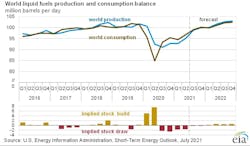EIA revises down slightly global oil demand growth forecasts for 2021
Consumption of global petroleum and other liquid fuels will grow by 5.3 million b/d in 2021, the US Energy Information Administration (EIA) forecast in the July Short-Term Energy Outlook (STEO), slightly lower than the previous forecast of 5.4 million b/d.
This demand growth follows a decline of 8.6 million b/d in 2020. Forecast growth in global oil consumption of 3.7 million b/d in 2022 would bring global oil consumption to 101.4 million b/d, which would be 400,000 b/d higher than in 2019.
EIA expects US liquid fuels consumption in 2021 to rise by 1.5 million b/d from 2020, making it the largest contributor to global consumption growth in the forecast. Liquids consumption in OECD Europe will be up 500,000 b/d for all 2021 compared with 2020.
However, oil consumption growth in many of the non-OECD regions remains more uncertain, EIA noted. Large-scale vaccination campaigns in Asia, Latin America, the Middle East, and Africa have been relatively slower—with some exceptions—than in Europe and the US. Outbreaks of COVID-19 infections and the re-imposition of restrictions on mobility and business activity still pose a significant downside risk in these regions.
In addition, the spread of COVID-19 variants and the effectiveness of the vaccines against these variants are significant risk factors to a full and sustained global recovery.
“India experienced its worst outbreak of COVID-19 infections in 2021 second quarter when the Delta variant spread, which is reportedly more virulent and contagious than other variants, and the outbreak led to a sharp reduction in economic activity from which the country is now slowly recovering. If the vaccines currently available are not effective against the Delta or other variants, countries will have to continue to rely on mobility and activity restrictions to mitigate the spread, which will lead to a longer, more drawn-out return in global oil demand,” EIA said.
Non-OPEC oil production
In the latest STEO, EIA said it expects non-OPEC production to rise by 1.1 million b/d in 2021 and by 3.1 million b/d in 2022. Canada and Brazil are expected to lead non-OPEC production growth in 2021 and the US and Russia to lead growth in 2022.
EIA forecasts that annual US crude oil production will average 11.1 million b/d in 2021, which is a 200,000 b/d decrease from 2020 levels. US crude oil production will rise to an average of 11.9 million b/d in 2022, EIA forecasts.
“Our forecast (US) crude oil production growth is based on WTI prices that indicate a favorable environment for drilling activity. In June, WTI prices averaged more than $70/bbl for the first time since October 2018, and we expect that through the end of 2022, WTI prices will remain above $60/bbl—a price that has signaled robust activity among US operators in the past. Because changes in rig counts typically lag changes in the WTI price by three to six months and production changes typically occur about two months after rig deployment, current crude oil price levels will not likely affect production until late 2021,” EIA said.
Russia is the second-largest producer of liquid fuels among non-OPEC countries after the US. Production in Russia grew by 500,000 b/d in first-half 2021 from second-half 2020, as OPEC+ participants eased crude oil production cuts. EIA expects Russia’s liquid fuels production to increase by 200,000 b/d for all of 2021 and by 800,000 b/d in 2022. After the OPEC+ agreement ends in early 2022, Russia’s production is expected to rise above 11.5 million b/d during second-half 2022, with annual average production in 2022 equal to 2019 levels.
EIA expects Canada’s production of petroleum and other liquid fuels to increase by more than 300,000 b/d in 2021, which would make it the leading source of non-OPEC liquid fuels supply growth this year. Output growth in 2021 is driven by increasing refinery demand for crude oil in the US, the end of Canadian government-ordered curtailments, and the restart of oil sands expansion projects that were deferred during 2020. The cancellation of the Keystone XL, which would have expanded Canada’s crude oil export capacity to the US by 830,000 b/d, does not materially affect production outlook for Canada.
OPEC crude
At the April 2021 OPEC+ meeting, the OPEC+ countries agreed to incrementally raise their production from May through July 2021, including a full reversal of Saudi Arabia’s voluntary production cut of 1 million b/d. They reaffirmed this agreement at their June meeting.
The forecast in this STEO was completed on July 1, prior to OPEC+ calling off its most recent meeting on July 5. However, EIA forecasts that OPEC and its OPEC+ partners will continue to increase crude oil production beyond July in response to rising global oil consumption.
In EIA’s forecast, OPEC crude oil production averages 28.2 million b/d in second-half 2021, up 2.9 million b/d from first-half 2021 and up 4.0 million b/d from second-half 2020. For all of 2021, EIA forecasts that OPEC crude oil production will average 26.8 million b/d, up 1.2 million b/d from 2020, and OPEC will raise crude oil production by an additional 1.8 million b/d in 2022 to 28.6 million b/d.
However, as EIA noted, its OPEC crude oil production forecast is subject to considerable uncertainty.
“OPEC+ has indicated it will adjust production targets in response to changes in global oil demand, but the path of global oil demand in the comings months remains highly uncertain. Also, the manner in which OPEC+ would change production targets in response to higher production from Iran, or other changes in the oil market, is not clear. Finally, country compliance with existing production targets as the oil price rises is uncertain,” EIA said.
